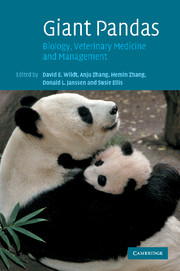Book contents
- Frontmatter
- Contents
- List of contributors
- Foreword
- Acknowledgements
- 1 The giant panda as a social, biological and conservation phenomenon
- 2 The Giant Panda Biomedical Survey: how it began and the value of people working together across cultures and disciplines
- 3 Factors limiting reproductive success in the giant panda as revealed by a Biomedical Survey
- 4 Significant medical issues and biological reference values for giant pandas from the Biomedical Survey
- 5 Life histories and behavioural traits as predictors of breeding status
- 6 Nutrition and dietary husbandry
- 7 Male reproductive biology in giant pandas in breeding programmes in China
- 8 Endocrinology of the giant panda and application of hormone technology to species management
- 9 The value and significance of vaginal cytology
- 10 Parentage assessment among captive giant pandas in China
- 11 The science of behavioural management: creating biologically relevant living environments in captivity
- 12 Evaluating stress and well-being in the giant panda: a system for monitoring
- 13 The neonatal giant panda: hand-rearing and medical management
- 14 Consequences of early rearing on socialization and social competence of the giant panda
- 15 Medical management of captive adult and geriatric giant pandas
- 16 Diseases and pathology of giant pandas
- 17 Ultrasonography to assess and enhance health and reproduction in the giant panda
- 18 Gastrointestinal endoscopy in the giant panda
- 19 Historical perspective of breeding giant pandas ex situ in China and high priorities for the future
- 20 Role and efficiency of artificial insemination and genome resource banking
- 21 Analysis of demographic and genetic trends for developing a captive breeding masterplan for the giant panda
- 22 Partnerships and capacity building for securing giant pandas ex situ and in situ: how zoos are contributing to conservation
- Index
- Plate Section
- References
5 - Life histories and behavioural traits as predictors of breeding status
Published online by Cambridge University Press: 09 August 2009
- Frontmatter
- Contents
- List of contributors
- Foreword
- Acknowledgements
- 1 The giant panda as a social, biological and conservation phenomenon
- 2 The Giant Panda Biomedical Survey: how it began and the value of people working together across cultures and disciplines
- 3 Factors limiting reproductive success in the giant panda as revealed by a Biomedical Survey
- 4 Significant medical issues and biological reference values for giant pandas from the Biomedical Survey
- 5 Life histories and behavioural traits as predictors of breeding status
- 6 Nutrition and dietary husbandry
- 7 Male reproductive biology in giant pandas in breeding programmes in China
- 8 Endocrinology of the giant panda and application of hormone technology to species management
- 9 The value and significance of vaginal cytology
- 10 Parentage assessment among captive giant pandas in China
- 11 The science of behavioural management: creating biologically relevant living environments in captivity
- 12 Evaluating stress and well-being in the giant panda: a system for monitoring
- 13 The neonatal giant panda: hand-rearing and medical management
- 14 Consequences of early rearing on socialization and social competence of the giant panda
- 15 Medical management of captive adult and geriatric giant pandas
- 16 Diseases and pathology of giant pandas
- 17 Ultrasonography to assess and enhance health and reproduction in the giant panda
- 18 Gastrointestinal endoscopy in the giant panda
- 19 Historical perspective of breeding giant pandas ex situ in China and high priorities for the future
- 20 Role and efficiency of artificial insemination and genome resource banking
- 21 Analysis of demographic and genetic trends for developing a captive breeding masterplan for the giant panda
- 22 Partnerships and capacity building for securing giant pandas ex situ and in situ: how zoos are contributing to conservation
- Index
- Plate Section
- References
Summary
INTRODUCTION
Among mammals, the giant panda is reproductively unique. The female is a seasonal, monoestrual breeder, experiencing a single- two to three-day period of sexual receptivity once per year, presumably triggered by increasing day length. In the wild, male giant pandas compete with conspecifics for access to oestrous females (Schaller et al., 1985). Giant pandas produce copious sperm numbers (see Chapter 7), presumably as ‘insurance’ to ensure conception and the perpetuation of the male's genes if given the opportunity to mate during a female's brief window of fertility. Although the extraordinarily short oestrus is a fascinating biological trait, it does not appear to limit reproductive success in captivity given that a sexually compatible male is available and breeding occurs. It does, however, present challenges for captive management for cub production.
The wild-born giant panda cub stays with its mother for 1.5 to 2.5 years (Schaller et al., 1985). This almost always is not the case in Chinese zoos and breeding centres, because of the practice of promoting annual cub production by early weaning, usually before six months of age (see Chapter 14). The consequences of this short-term gain on long-term development remain a question, and studies are continuing on the impact of disrupted early rearing on adverse behaviours, including inappropriate aggression, inadequate sexual behaviour and/or incompetent maternal behaviour (see Chapter 14). These anomalies are rather common in the ex situ giant panda world. Many males tend to show aggressive rather than affiliative behaviours, even to females demonstrating strong oestrus.
- Type
- Chapter
- Information
- Giant PandasBiology, Veterinary Medicine and Management, pp. 87 - 100Publisher: Cambridge University PressPrint publication year: 2006
References
- 1
- Cited by



